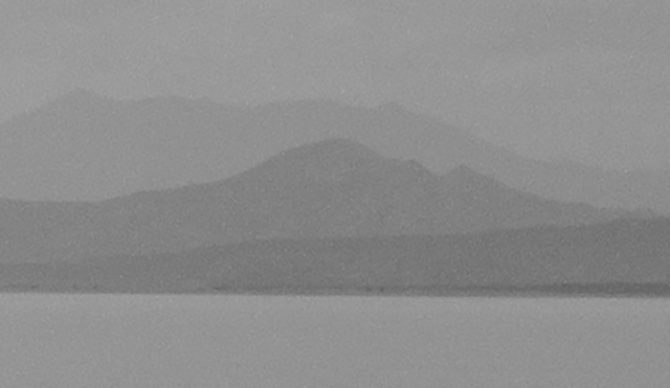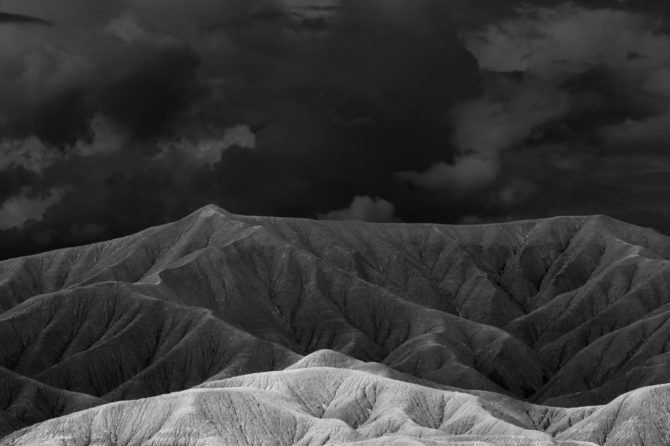July 24, 2015
Canon 5DSr Noise Issues
Overshadowed
I’ve returned from my first outing with my new Canon 5DSr and wanted to report back on what I thought of my first images.
The image above was shot at 1/80 of a second and I was impressed with the quality. I was able to blow it up much larger than images from the 5D Mk III and have it hold its detail. I am happy with the quality of this image.
The next image is from the Spiral Jetty on the Great Salt Lake, this image was shot at 240 seconds:
Spiral Jetty
The quality of this image was very disappointing. I opened the RAW file and it was so noisy that I didn’t think that I could salvage this image. By using the dust and scratch filter in Photoshop and by adding grain, I was able to make this image “acceptable.”
I suspected the noise came from the long exposure and I was in fact worried about this going in. The larger number of pixels packed into the same area means that the pixels are smaller and more prone to noise, especially during long exposures. But I didn’t expect this poor of a result.
I then found the same image that I had shot at 120 seconds and compared a blown up section of the two:

240 seconds

120 seconds
.
The noise at 120 seconds is reasonable while at 240 seconds the noise is completely unacceptable. I only have a few shots to judge this by, but all of my longer exposures have this noise and so I’m sorry to report that my first results with the 5DSr are disappointing from a long exposure perspective.
I will do some formal testing to see how exposure times affects noise levels. As I learn more, I’ll let you know what I find. And if you know something about this issue, please share it with everyone.
Cole



What ISO were you using?
I was having a similar problem with white spots on high-ISO images. After some research, I found my 7D has a feature called “Long exposure noise reduction” (C.Fn II: Image). After disabling this feature, the white spots disappeared.
I also received my new camera and took it out for the 1st time yesterday to shoot some long exposures. Though the image was sharp the noise was terrible at the long times 180 seconds and 300 seconds. the normal exposures even at -2EV were dark but I could up the shadows and there was no noise. I also will try with shorter long exposures, but the noise is a major issue. I googled to see if there were any comments and I came up with your post.
200 ISO, so that should not be the problem.
I did have a problem with the 5D Mk III at ISO 400 with very long exposures, but even those did not have the noise the 5DSr has.
I am shooting at ISO 100. I do not like to use the long exposure noise reduction when shooting 3-8 minute shots. I will give it a try.
This was definitely not necessary with the 5D Mk III. The long exposures at 8 minutes were clean. This sensor is a whole different story.
Cole,
This is really surprising. I’ve taken photos as long as 7-8 minutes with my D800e (ISO 100) and had no appreciable noise.
However, since I’ve begun using a M4/3 camera (Olympus OMD-EM1),on the other hand, in camera noise reduction is absolutely necessary for anything over 20 seconds. I hope using NR, as recommended by Paul, solves your problem.
Another approach that works for me (assuming you are shooting in RAW at base ISO) is, when you take the shot, over expose your image significantly (without blowing out the highlights) and then darken it in post processing. This will radically reduce the apparent noise, especially in the shadows.
Yes, using the in-camera Noise Reduction may well work, but it turns a 4 minute exposure into an 8 minute one! I’m not a fan of this approach.
Wow! This is a fascinating and arresting moment. I want to believe that newer is synonymous with better, particularly when “newer” lightens your purse close to $4K.
The lesson for me, waiting for Nikon’s equivalent, is to not get in line until the reviews like this are filed, particularly for LE shooters.
Hopefully if more bad reviews follow, Canon will step up with a fix, if possible. Cole, I hope they read your post.
Hi, I would like to mention that I had originally advised *disabling* long exposure noise reduction, not *enabling*.
In my camera settings, I had also disabled “High ISO speed noise reduction” as this feature “bakes in” Canon’s proprietary noise reduction into its RAW file and that it is not recognized by Lightroom or Photoshop as a separate setting or feature, such as colour temperature or exposure compensation. In my experience, applying noise reduction in Lightroom or Photoshop after it had already been applied in-camera yielded worse results, not better.
I’m a big believer in capturing the “raw” in RAW and leaving the post-production work for the computer.
Cole,
Re Long Exposure NR: I agree, I never used it because it doubles the length of the shot(I often took 7-8 minute exposures). Fortunately, with the Nikon it wasn’t necessary. Unfortunately, my Oly requires it or else I get results much worse than the one you showed.
Wish I had known that before I sold the Nikon.
http://www.takegreatpictures.com/photo-tips/software-tips-and-techniques/dark-frame-subtraction-using-adobe-photoshop-br-by-chris-limone
Hope this helps Cole.. I imagine the dark frame would be similar from evening to evening so perhaps you could do one at the end of your outing?
What was the air temperature, when you shot these images? I could guess that it was a very hot day at the Great Salt Lake. Given that there was no noise issue at 120s, however at 240s (4 min), I would suspect an overheating sensor.
From the Exif data I see that you took these shots around 2:30pm and the 240s was taken after the 120s exposure.
Carsten, it was a warm day, to be sure. Perhaps the 5DSr is a “winter only” camera? (smile)
Cole, I think you and Joel need to get over using the NR. When you spend quite a lot of time setting up an exposure and going through the entire rigamorole for long exposures – so what if you have to wait an equal amount of time for the NR to do it’s thing? I’ve shot night exposures up to 30 minutes with my D810 and the results are worth it. 6 minutes? You can’t wait around for 6 freakin’ minutes? I think most landscape photographers are very patient people – this should not be difficult.